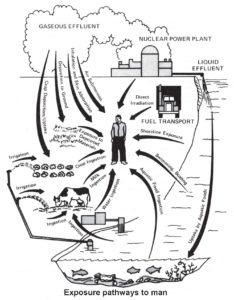Nuclear Power & Radiation Exposure
Nuclear Power & Radiation Exposure
What are the health impacts of living near a nuclear reactor? It’s difficult to say for sure. What we do know is that radiation damages living cells, and that nuclear power plants are permitted to release small amounts of radioactive materials into the environment – to say nothing of the potential impact of an unintentional release, or accident.
Why and How Nuclear Plants Release Radioactive Materials
To generate electricity at a nuclear power plant, a nuclear reactor uses uranium fuel to produce heat energy through nuclear fission in a reactor. Nuclear fission creates radioactive material, known as radioisotopes. Some of these radioisotopes – such as iodine 131, cesium 137, strontium 90, tritium, uranium and plutonium – can be deadly to humans and harmful to the environment.

A 1977 diagram by the NRC explains routine radiological releases.
In a perfect world, the harmful byproducts of producing nuclear power would be isolated from humans and the environment. Today’s nuclear power plants, however, must regularly release radioactive water and gases to the environment to maintain proper conditions in the reactor, as well as to keep radioactivity from exceeding government safety limits for workers. These releases are regulated by and reported to the U.S. Nuclear Regulatory Commission.
Health Impacts of Radiation Exposure
Energy emitted from a source is generally referred to as radiation. Radiation with enough energy to remove tightly bound electrons from the orbit of an atom, causing the atom to become charged or ionized, is referred to as ionizing radiation. This energy is released in the form of subatomic particles (alpha and beta) or waves (gamma and X rays).

Penetration varies by type of radiation.
Exposure to ionizing radiation causes damage to living tissue. High doses can result in mutation, cancer, radiation sickness, and death. Cancers linked to ionizing radiation include most blood cancers (leukemia, lymphoma), lung cancer, and many solid tumors of various organs. Birth defects can include congenital malformations, spinal defects, and kidney and liver damage.
Effects on human health vary by an individual’s age and health, as well as by the type of radionuclide, level of exposure, and duration of exposure. Children and the unborn are especially susceptible because of their rapid cell division during growth. Adults with weakened immune systems may also be more sensitive to exposure.
“There is no such thing as a radiation exposure that will not do damage. There is a hundred per cent possibility that there will be damage to cells. The next question is: which damage do you care about?”
– Dr. Rosalie Bertell, international expert on radiation
Click hereto download a PDF fact sheet.
C-10 Research & Education Foundation, Inc.
11 Chestnut Street
Amesbury, MA 01913
Phone: (978) 465-6646
Email: info@c-10.org
© C-10 Research and Education Foundation 2025 C-10 is a registered 501(c)(3) nonprofit. Tax ID/EIN #22-3117209.

